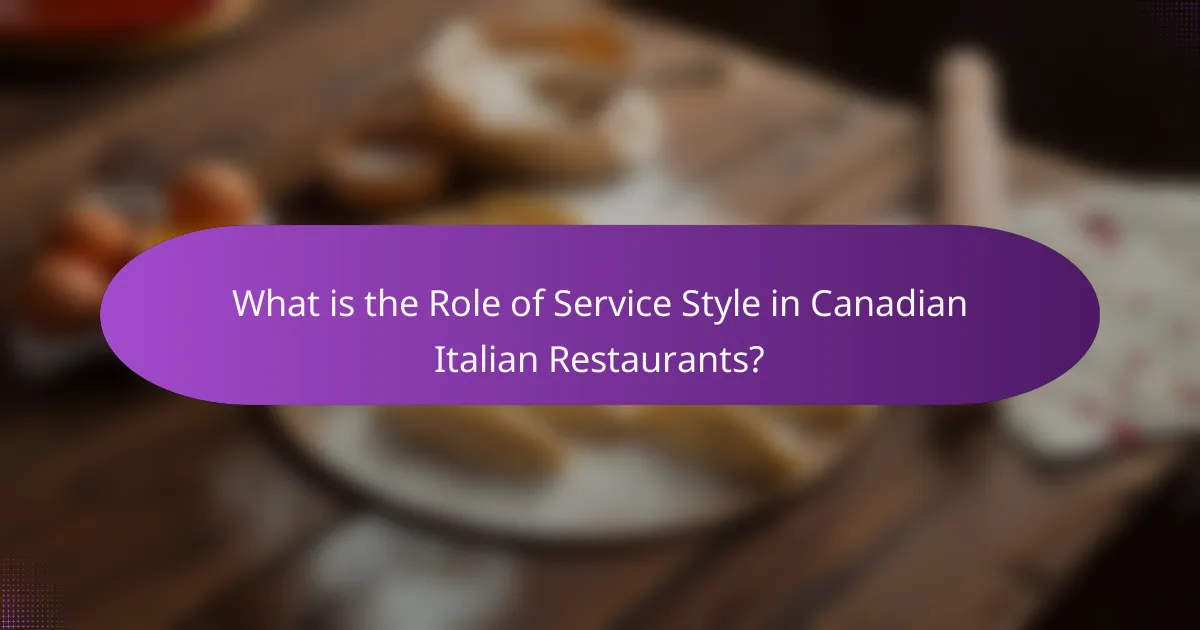
What is the Role of Service Style in Canadian Italian Restaurants?
Service style in Canadian Italian restaurants significantly influences the dining experience. It encompasses the manner in which food is presented and served to customers. Casual dining typically features a relaxed atmosphere with friendly, informal service. Fine dining, on the other hand, emphasizes polished service and attention to detail. Takeout options focus on efficiency and convenience for customers.
The service style affects customer satisfaction and retention rates. According to a 2020 survey by the Canadian Restaurant and Foodservices Association, 75% of diners prioritize service quality when choosing a restaurant. This highlights the critical role service style plays in attracting and maintaining clientele in Canadian Italian restaurants.
How does service style influence the dining experience in Canadian Italian restaurants?
Service style significantly influences the dining experience in Canadian Italian restaurants. Casual dining typically offers a relaxed atmosphere with friendly, informal service. This approach encourages social interaction among diners and enhances comfort. Fine dining, on the other hand, emphasizes a formal service style with attention to detail. This includes personalized interactions and a focus on the presentation of dishes.
Takeout options provide convenience and flexibility, catering to customers who prefer dining at home. Research indicates that service style impacts customer satisfaction and repeat visits. A study published in the Journal of Hospitality Management found that attentive service correlates with higher customer loyalty. Therefore, the chosen service style shapes the overall perception and enjoyment of the dining experience.
What are the key elements that define service style in this context?
Service style in Canadian Italian restaurants is defined by elements such as atmosphere, customer interaction, and service speed. The atmosphere includes decor, lighting, and overall ambiance, which create a welcoming environment. Customer interaction encompasses the level of engagement and attentiveness from staff, impacting the dining experience. Service speed varies between casual dining and fine dining, where fine dining typically emphasizes a slower, more deliberate pace. Additionally, menu presentation and staff knowledge about the offerings are crucial. These elements collectively shape the overall service style, influencing customer satisfaction and repeat patronage.
How do different service styles cater to diverse customer preferences?
Different service styles cater to diverse customer preferences by offering tailored experiences. Casual dining provides a relaxed atmosphere, appealing to families and groups. Fine dining focuses on an upscale experience, attracting customers seeking luxury and exclusivity. Takeout options cater to convenience-oriented customers who prioritize speed and ease. Each style addresses specific needs, such as social interaction in casual settings or formal service in fine dining. Research shows that 70% of diners prefer casual environments for social gatherings. Meanwhile, 60% of customers choose fine dining for special occasions. This data highlights how service styles align with customer expectations and preferences.
Why are Casual Dining, Fine Dining, and Takeout Options significant in Canadian Italian restaurants?
Casual dining, fine dining, and takeout options are significant in Canadian Italian restaurants because they cater to diverse customer preferences and dining experiences. Casual dining offers a relaxed atmosphere, appealing to families and groups seeking affordable meals. Fine dining provides an upscale experience, attracting those looking for high-quality cuisine and exceptional service. Takeout options meet the needs of busy customers who prefer convenience without sacrificing quality. Together, these service styles enhance customer satisfaction and broaden market reach, contributing to the overall success of Canadian Italian restaurants.
What distinguishes casual dining from fine dining in terms of service style?
Casual dining is characterized by a relaxed service style, while fine dining offers a more formal and attentive service approach. In casual dining, servers typically have a less structured interaction with guests. They may provide quicker service and a more laid-back atmosphere. In contrast, fine dining emphasizes a high level of customer service, often including multiple courses and detailed menu explanations. Fine dining establishments usually employ trained staff to enhance the dining experience. This includes personalized attention and a focus on presentation. The service style in fine dining often involves more rituals, such as wine pairing and table-side preparations. Overall, the distinctions in service style reflect the different dining experiences offered by casual and fine dining establishments.
How do takeout options integrate service style into the overall experience?
Takeout options integrate service style into the overall experience by offering convenience and personalization. Customers expect a seamless ordering process, which reflects the restaurant’s service quality. Efficient communication, such as clear menus and timely updates, enhances customer satisfaction. Packaging also plays a crucial role; it should maintain food quality and reflect the restaurant’s brand image. Additionally, the option for customization allows customers to feel involved in their meal selection. Research indicates that positive takeout experiences can lead to repeat business and customer loyalty. Overall, the integration of these elements contributes to a cohesive dining experience, even when not dining in.

What are the characteristics of Casual Dining in Canadian Italian Restaurants?
Casual dining in Canadian Italian restaurants is characterized by a relaxed atmosphere and approachable service. These establishments typically feature a diverse menu that includes classic Italian dishes and local adaptations. The dining experience is informal, encouraging patrons to enjoy meals at a leisurely pace.
Table service is common, with servers providing recommendations and assistance. Restaurants often have a family-friendly environment, making them suitable for gatherings. The decor tends to be warm and inviting, often incorporating Italian cultural elements.
Pricing is generally moderate, appealing to a wide range of customers. Many casual Italian restaurants also offer takeout options, catering to the convenience of diners. Overall, the focus is on comfort, quality food, and a welcoming experience.
How does the service style in casual dining enhance customer satisfaction?
The service style in casual dining enhances customer satisfaction by providing a relaxed and friendly atmosphere. This approach encourages open communication between staff and customers. Quick service is a key component, ensuring that diners receive their orders promptly. Personalization of service, such as remembering regular customers’ preferences, builds rapport and loyalty. Additionally, staff training focuses on hospitality, which improves the overall dining experience. Research shows that 70% of customers value service quality as a major factor in their satisfaction. Overall, the combination of friendly interactions and efficient service creates a positive dining environment.
What specific attributes define the service style in casual dining settings?
Casual dining service style is defined by several specific attributes. These include a relaxed atmosphere, friendly staff interaction, and moderate table service. Guests typically order from a menu at their table. The service is attentive but not overly formal. Waitstaff often check in periodically without being intrusive. Additionally, casual dining establishments usually feature a diverse menu. This includes a range of price points to accommodate different budgets. These attributes collectively contribute to a welcoming dining experience.
How do staff interactions differ in casual dining compared to other styles?
Staff interactions in casual dining are generally more relaxed and informal compared to fine dining. In casual dining, staff often engage in friendly conversations with guests. This creates a welcoming atmosphere that encourages customer interaction. For example, servers may share personal anecdotes or recommendations. In contrast, fine dining staff maintain a more professional demeanor. Their interactions are typically focused on service efficiency and formal communication. Additionally, casual dining staff may address customers by name or use informal language. This personal touch fosters a sense of familiarity and comfort. Conversely, fine dining staff adhere to strict etiquette and protocols. This distinction highlights the varying levels of formality in staff interactions across dining styles.
What role does ambiance play in casual dining service style?
Ambiance plays a crucial role in casual dining service style. It sets the mood and atmosphere for diners. A well-designed ambiance enhances the dining experience. Elements like lighting, music, and decor contribute significantly. For instance, warm lighting can create a welcoming feel. Soft background music can encourage conversation. Research indicates that ambiance influences customer satisfaction and repeat visits. According to a study by Kwortnik and Thompson (2009), ambiance is a key factor in perceived service quality. This shows that an appealing ambiance can attract and retain customers in casual dining settings.
How does decor influence the perception of service quality in casual dining?
Decor significantly influences the perception of service quality in casual dining. A well-designed decor creates a welcoming atmosphere. This atmosphere enhances customer comfort and satisfaction. Studies show that appealing decor can lead to higher customer expectations. Customers often associate attractive environments with better service. For example, a restaurant with tasteful decor may be perceived as more attentive. This perception can result in increased customer loyalty and repeat visits. Research indicates that ambiance, including decor, impacts overall dining experience ratings. Thus, decor plays a crucial role in shaping service quality perceptions.
What are common practices in casual dining that enhance the service experience?
Common practices in casual dining that enhance the service experience include attentive customer service, a welcoming atmosphere, and efficient order management. Attentive customer service involves staff being responsive to guest needs and providing timely assistance. A welcoming atmosphere is created through friendly interactions and a comfortable environment. Efficient order management ensures that food is served promptly and accurately. These practices contribute to customer satisfaction and repeat visits. Studies show that positive service experiences lead to higher customer loyalty in the restaurant industry.

What defines Fine Dining service style in Canadian Italian Restaurants?
Fine Dining service style in Canadian Italian Restaurants is characterized by high-quality service and a refined atmosphere. This style includes attentive and personalized service from well-trained staff. Guests often experience a multi-course meal that highlights authentic Italian cuisine. The dining environment is typically elegant, featuring upscale decor and table settings. Additionally, fine dining establishments often offer an extensive wine list to complement the dishes. The focus is on creating a memorable dining experience through attention to detail and exceptional service. Many Canadian Italian fine dining restaurants emphasize locally sourced ingredients, enhancing the authenticity of the cuisine.
How does fine dining service style elevate the overall dining experience?
Fine dining service style elevates the overall dining experience by offering personalized attention and meticulous service. This service style typically includes trained staff who are knowledgeable about the menu. They provide recommendations based on guests’ preferences. The ambiance is carefully curated to enhance the dining atmosphere. Fine dining often features elegant table settings and attentive service. This creates a sense of occasion and exclusivity. Research shows that diners in fine dining settings report higher satisfaction levels due to the overall experience. According to a study published in the Journal of Hospitality Management, quality service significantly influences customer perception of value in dining.
What unique attributes set fine dining service apart from casual dining?
Fine dining service is distinguished by several unique attributes that set it apart from casual dining. One key attribute is the level of service; fine dining often features highly trained staff providing attentive and personalized service. Another unique attribute is the ambiance; fine dining establishments typically offer an elegant and sophisticated atmosphere with carefully curated decor.
Additionally, the menu in fine dining restaurants is usually more refined, featuring gourmet dishes made from high-quality ingredients. Presentation is also a critical aspect; dishes are often artistically arranged to enhance the dining experience.
Moreover, fine dining experiences often include multiple courses, allowing guests to savor a variety of flavors. Reservations are commonly required, ensuring a more exclusive experience. Lastly, fine dining establishments may offer sommelier services for wine pairing, enhancing the overall culinary experience. These attributes collectively create a more luxurious and memorable dining experience compared to casual dining.
How do staff training and expertise impact service in fine dining environments?
Staff training and expertise significantly enhance service quality in fine dining environments. Well-trained staff possess in-depth knowledge of menu items and wine pairings. This expertise enables them to make informed recommendations to guests. Additionally, trained staff demonstrate refined service techniques, such as proper table settings and etiquette. This attention to detail creates a more enjoyable dining experience. Studies show that fine dining establishments with skilled staff receive higher customer satisfaction ratings. For instance, a survey by the National Restaurant Association found that 70% of diners value knowledgeable servers. Overall, effective training directly correlates with improved service levels and guest satisfaction in fine dining.
What are the expectations of customers in fine dining settings?
Customers in fine dining settings expect exceptional service and high-quality food. They anticipate a refined atmosphere that includes elegant décor and a well-curated ambiance. Attention to detail is crucial, with staff trained to provide personalized service. Customers look for knowledgeable servers who can recommend wine pairings and describe menu items expertly. They expect a diverse and innovative menu featuring seasonal and locally sourced ingredients. Reservation management is important, with expectations for timely seating and minimal wait times. Customers also value privacy and a comfortable dining experience, often preferring quieter settings. Overall, fine dining customers seek an experience that justifies the premium pricing through quality and service.
How do fine dining establishments manage customer interactions to ensure satisfaction?
Fine dining establishments manage customer interactions through personalized service and attention to detail. Staff members are trained to anticipate guest needs and preferences. This includes remembering previous visits and special occasions. Communication is key; servers engage with customers to create a welcoming atmosphere. They provide detailed menu descriptions and wine pairings. Feedback is actively sought during and after the meal. Many restaurants implement reservation systems to streamline the dining experience. These practices contribute to a memorable experience, leading to higher customer satisfaction rates. Studies show that personalized service can increase repeat visits by up to 70%.
What role does presentation play in the service style of fine dining?
Presentation plays a crucial role in the service style of fine dining. It enhances the overall dining experience and reflects the restaurant’s quality. Fine dining relies on visual appeal to stimulate appetite and convey artistry. Each dish is meticulously arranged to showcase ingredients and textures. This attention to detail signifies sophistication and care. Research indicates that visual presentation influences perception of taste and quality. A well-presented dish can elevate customer satisfaction and encourage repeat visits. In fine dining, presentation is not just aesthetic; it is integral to the culinary experience.

How are Takeout Options shaping service style in Canadian Italian Restaurants?
Takeout options are significantly shaping service style in Canadian Italian restaurants. These options promote a more casual dining experience. Customers increasingly prefer the convenience of takeout. This shift encourages restaurants to streamline their service processes. Many establishments have adapted by simplifying menus for takeout. This ensures quicker preparation and delivery. Takeout also influences packaging design, focusing on preserving food quality. Additionally, restaurants are investing in online ordering systems. These systems enhance customer experience and efficiency. The rise of takeout reflects changing consumer preferences in dining.
What are the key differences between service styles for dine-in versus takeout?
Dine-in and takeout service styles differ primarily in customer interaction and food presentation. Dine-in service involves direct interaction with waitstaff. Customers receive menus, place orders, and enjoy meals in a restaurant setting. This style often includes table service, where food is brought directly to the table. In contrast, takeout service focuses on efficiency and convenience. Customers place orders for food to be consumed off-premises. Food is packaged for transport, often requiring less interaction with staff.
Dine-in experiences often emphasize ambiance and presentation. Restaurants may invest in decor and table settings to enhance the dining experience. Takeout services prioritize speed and packaging over presentation. Food must remain intact during transport, influencing how dishes are prepared and packaged.
According to a study by the National Restaurant Association, 60% of consumers prefer takeout for convenience. However, dine-in still appeals due to the overall experience it offers. These differences highlight the unique attributes of each service style in Canadian Italian restaurants.
How do restaurants ensure quality service in takeout orders?
Restaurants ensure quality service in takeout orders by implementing standardized procedures. They train staff on proper packaging techniques to maintain food temperature and presentation. Many restaurants use insulated containers to keep meals hot during transit. They also provide clear labeling for each item to avoid confusion. Communication with customers is prioritized through order confirmation and estimated pick-up times. Regular feedback is collected to improve service quality. Quality control checks are performed before orders leave the kitchen. These practices enhance customer satisfaction and loyalty in takeout service.
What strategies do restaurants use to maintain customer engagement in takeout services?
Restaurants use various strategies to maintain customer engagement in takeout services. They often utilize social media to promote special offers and menu items. Engaging content, such as behind-the-scenes videos, keeps customers interested. Loyalty programs incentivize repeat orders and enhance customer retention. Personalized communication, like targeted emails, fosters a connection with customers. Feedback collection through surveys helps improve services based on customer preferences. Offering limited-time promotions creates urgency and encourages orders. Additionally, user-friendly online ordering systems streamline the process, enhancing customer experience. These strategies collectively contribute to sustained customer engagement in takeout services.
What challenges do Canadian Italian restaurants face with takeout service?
Canadian Italian restaurants face several challenges with takeout service. One major challenge is maintaining food quality during transportation. Dishes may lose their freshness and texture, affecting customer satisfaction. Another issue is packaging, which must keep food hot and prevent spillage. Additionally, competition from other restaurants offering takeout can impact sales.
Restaurants also struggle with staffing shortages, making it difficult to handle increased takeout orders. Managing online orders can lead to technical issues, causing delays and errors. Lastly, fluctuating demand can create inventory management challenges, leading to food waste.
How do restaurants adapt their service style to meet the demands of takeout customers?
Restaurants adapt their service style for takeout customers by streamlining order processes. They often implement online ordering systems to enhance convenience. Many restaurants also optimize their menus for takeout, focusing on items that travel well. Packaging is designed to maintain food quality during transport. Staff training emphasizes efficiency in preparing and packaging orders. Communication is improved through notifications about order status. Additionally, some restaurants offer curbside pickup to enhance customer experience. These adaptations reflect changing consumer preferences and the growing demand for takeout services.
What best practices can improve the takeout experience for customers?
To improve the takeout experience for customers, restaurants should focus on packaging, communication, and efficiency. High-quality packaging prevents spills and maintains food temperature. Clear labeling of items helps customers identify their orders quickly. Timely communication about order status enhances customer satisfaction. Efficient processes reduce wait times, making the experience smoother. Implementing these practices can lead to higher customer retention. According to a study by the National Restaurant Association, 60% of customers prefer takeout options with reliable packaging and clear communication.
What are some best practices for enhancing service style across all dining options?
Best practices for enhancing service style across all dining options include training staff on menu knowledge and customer interaction. Staff should be knowledgeable about ingredients, preparation methods, and wine pairings. This knowledge allows them to provide tailored recommendations to guests. Consistent service standards should be established across all dining formats. This ensures that guests receive a similar level of service whether dining in or ordering takeout.
Engaging with guests is crucial. Staff should greet customers promptly and check in during the meal to address any needs. Personalizing the dining experience can enhance guest satisfaction. For instance, remembering repeat customers’ preferences can create a welcoming atmosphere.
Implementing feedback mechanisms is essential. Surveys or comment cards can help restaurants understand areas for improvement. Regular staff training sessions should be conducted to reinforce service standards and introduce new techniques.
Finally, maintaining a clean and inviting environment is fundamental. A well-organized space contributes to a positive dining experience. These practices collectively enhance service style and improve customer satisfaction across all dining options.
The main entity of the article is the service style in Canadian Italian restaurants, which encompasses casual dining, fine dining, and takeout options. The article examines how different service styles influence the dining experience, customer satisfaction, and retention rates. It discusses key elements that define service style, including atmosphere, customer interaction, and service speed, while also highlighting the unique attributes of each dining format. Additionally, the article addresses the challenges faced by restaurants in adapting to takeout demands and presents best practices for enhancing service quality across all dining options.


